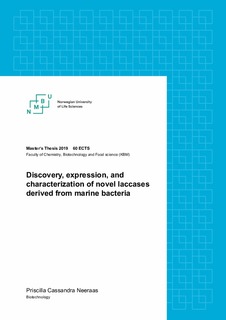| dc.contributor.advisor | Vaaje-Kolstad, Gustav | |
| dc.contributor.advisor | Wentzel, Alexander | |
| dc.contributor.author | Neeraas, Priscilla Cassandra | |
| dc.date.accessioned | 2019-10-23T11:52:48Z | |
| dc.date.available | 2019-10-23T11:52:48Z | |
| dc.date.issued | 2019 | |
| dc.identifier.uri | http://hdl.handle.net/11250/2623939 | |
| dc.description.abstract | Lignocellulose is the most abundant biomass on Earth and is primarily composed of three organic polymers; cellulose, hemicellulose, and lignin. Established technology exists to produce useful products such as fuels and chemicals from cellulose and hemicellulose. However, lignin has today still limited use for value creation. Every year, vast amounts of lignin is produced as an industrial byproduct, especially in the pulp and paper industry where about 98% of the material is burned to produce energy. The dependence on fossil resources to make fuels, chemicals and consumer goods has devastating effects on the environment, and growing concerns have resulted in an increasing demand for greener and more sustainable products. In a biorefinery setting, lignin has the potential to be used for the production of a range of bio-based chemicals and materials, and the use of enzymes for lignin valorization is considered a promising approach in the biorefinery industry.
Laccases are multi-copper oxidases that catalyze the one-electron oxidation of a variety of small phenolic substances, with simultaneous reduction of molecular oxygen to water. Bacterial laccases have been shown to depolymerize lignin through mediator substances, in so-called laccase-mediator systems (LMS). Mediators are thereby small phenolic substances that can be oxidized by laccase followed by non-enzymatic oxidation and breakdown of lignin. Despite of their advantages, known bacterial laccases still lack behind their fungal counterparts with respect to potency to degrade lignin. Therefore, discovery of new and engineering of known bacterial laccases are needed to efficiently apply them in lignin depolymerization and upgrading at large scale.
This study targeted both the discovery and description of new, and the engineering of a well-established bacterial laccase for potential future uses in this field. The work performed has resulted in in-depth knowledge about four newly discovered laccases from marine Actinobacteria with high thermotolerance and the potential to act as lignin degraders in a laccase-mediator system. Following substrate screening of a variety of small phenolic substances, one candidate, P20-F12, was observed to oxidize four potential mediator compounds. In efforts to develop a spectrophotometric assay for lignin degradation by LMS, the use of two mediators (ABTS and sinapic acid) was attempted. However, conversion of both mediators interfered with the spectrophotometric detection of lignin oxidation. Further work is needed to establish a reliable assay to monitor lignin oxidation, e.g. involving mass spectrometry.
Vanillin has been observed to be directly derivable from Kraft lignin, and can hence function as a potential laccase mediator in lignin depolymerization. The highly thermostable laccase CotA, originating from Bacillus subtilis, underwent site-directed mutagenesis in an attempt to make the enzyme active against vanillin. Several amino acid mutations were suggested based on the substrate-binding of sinapic acid, which shares structural similarities with vanillin. Combining the two amino acid mutations P226M and L386A in CotA resulted in loss of activity towards the synthetic substrate ABTS, while each single mutation allowed the enzyme to retain its activity towards ABTS. The CotA variants were still not active against vanillin but lay the basis for further engineering on the way to the final aim of efficient vanillin oxidation by CotA.
The findings from the research performed, underline that bacterial laccases have potential to be used as lignin degraders in a laccase-mediator system. However, further research is necessary to characterize the four Actinobacteria laccases more extensively in terms of their stability in efficient enzyme systems for lignin degradation. Further research should in particular include the search for and engineering of bacterial laccases with higher enzymatic efficiency, and the four newly discovered Actinobacteria laccases could represent new basis for enzyme engineering through site-directed mutagenesis and molecular evolution. For that, it would also be expedient to develop new lignin assays that allow the rapid detection of lignin oxidation and breakdown. | nb_NO |
| dc.description.abstract | Lignocellulose er den mest rikelige formen for biomasse på jorda og er primært bygget opp av tre organiske polymerer; cellulose, hemicellulose, og lignin. Veletablerte teknologier eksisterer for å produsere nyttige produkter slik som brensel og kjemikalier fra cellulose og hemicellulose. Lignin, derimot, har i dag begrenset bruk som nyttelses produkter. Hvert år produseres det store mengder lignin som industrielt biprodukt, spesielt i papir industrien hvor omtrent 98% av materialet blir brent for energiproduksjon. Avhengigheten av fossile ressurser for å lage brensel, kjemikalier, og forbruksvarer har ødeleggende effekt på miljøet, og økende bekymring har resultert i økt etterspørsel etter grønnere og mer bærekraftige produkter. I en bioraffineri setting har lignin potensiale til å bli brukt i produksjonen av en rekke bio-baserte kjemikalier og materialer, og bruk av enzymer for lignin foredling er sett på som en lovende tilnærming i bioraffineri industrien. | nb_NO |
| dc.language.iso | eng | nb_NO |
| dc.publisher | Norwegian University of Life Sciences, Ås | nb_NO |
| dc.rights | Attribution-NonCommercial-NoDerivatives 4.0 Internasjonal | * |
| dc.rights.uri | http://creativecommons.org/licenses/by-nc-nd/4.0/deed.no | * |
| dc.subject | Laccases | nb_NO |
| dc.subject | Lignin | nb_NO |
| dc.subject | Actinobacteria | nb_NO |
| dc.title | Discovery, expression, and characterization of novel laccases derived from marine bacteria | nb_NO |
| dc.title.alternative | Oppdagelse, uttrykk og karakterisering av nye lakkaser funnet i marine bakterier | nb_NO |
| dc.type | Master thesis | nb_NO |
| dc.description.localcode | M-BIOTEK | nb_NO |

